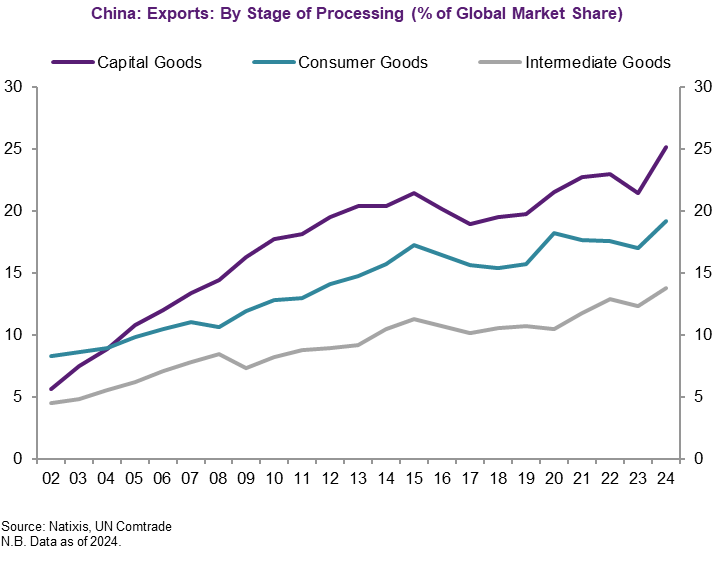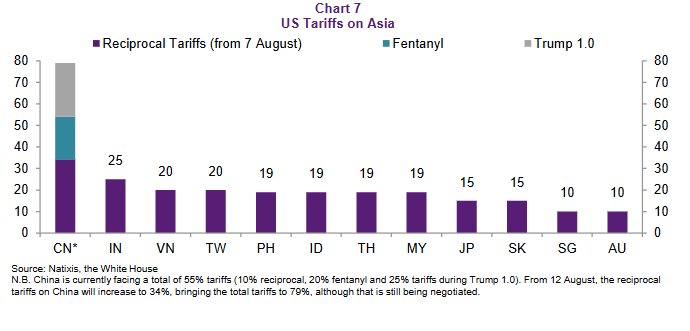Here we go, as I'll go on TV soon with @JoumannaTV to discuss data, let's take a look at China September trade data that just came out.
September exports rose 8.3%YoY in USD and imports increased 7.4%YoY.
Year-to-date, exports grew 6.1% while imports declined -1.1%YoY.
September exports rose 8.3%YoY in USD and imports increased 7.4%YoY.
Year-to-date, exports grew 6.1% while imports declined -1.1%YoY.
By destination, China exports to the US fell -16.9% but to Asia rising rapidly.
Exports to India rose 12.9% and India deficit with China is accelerating, with imports not just intermediates for production but also final consumer goods.
Shipment to ASEAN rose 14.7% with fastest growth to Thailand and Vietnam (+22.5% and 22.3%, respectively). The sharp increase of shipment reflect supply chain diversification but also rising imports for domestic demand in ASEAN that also poses challenges to domestic industries.
Exports to the EU rose 8.2% with shipment to Germany increasing +10.5%.
Interestingly, China exports to Russia has fallen this year by -11.3% as Russia puts up curbs to some Chinese exports.
Exports to India rose 12.9% and India deficit with China is accelerating, with imports not just intermediates for production but also final consumer goods.
Shipment to ASEAN rose 14.7% with fastest growth to Thailand and Vietnam (+22.5% and 22.3%, respectively). The sharp increase of shipment reflect supply chain diversification but also rising imports for domestic demand in ASEAN that also poses challenges to domestic industries.
Exports to the EU rose 8.2% with shipment to Germany increasing +10.5%.
Interestingly, China exports to Russia has fallen this year by -11.3% as Russia puts up curbs to some Chinese exports.
China trade surplus in September:
#1 EU 22.9
#2 USA 22.8bn
#3 ASEAN 17.2bn
#4 India 10.3bn
#1 EU 22.9
#2 USA 22.8bn
#3 ASEAN 17.2bn
#4 India 10.3bn
Imports by China year-to-date:
US -11.6% so trade relations falling both ways
ASEAN -0.5% with imports from Malaysia falling -14%
EU -3.2% with contraction across Italy, Germany, France etc.
India -2.3% and it really doesn't import much (only about 10% of what it exports to India)
Australia -10.5% (downward commodity demand)
Where is it growing in imports?
Japan +5.6% (driven by high-tech)
Taiwan +8% (driven by high-tech)
South Korea +2.2% (also chips/AI)
US -11.6% so trade relations falling both ways
ASEAN -0.5% with imports from Malaysia falling -14%
EU -3.2% with contraction across Italy, Germany, France etc.
India -2.3% and it really doesn't import much (only about 10% of what it exports to India)
Australia -10.5% (downward commodity demand)
Where is it growing in imports?
Japan +5.6% (driven by high-tech)
Taiwan +8% (driven by high-tech)
South Korea +2.2% (also chips/AI)
Oh forgot to say imports from Russia also down -7.7%YoY ytd so trade really not growing between BRICS even if geopolitics is.
So what is the bottom line looking at this? Well, listen, here is the reality.
China is GROWING its exports in every direction: labor intensive, medium skilled, and high-tech.
But China is only importing what it needs and don't have yet so basically high tech (also raw commodities but that is down trend this year) from North Asians where it can.
What is the meaning of it?
So what is the bottom line looking at this? Well, listen, here is the reality.
China is GROWING its exports in every direction: labor intensive, medium skilled, and high-tech.
But China is only importing what it needs and don't have yet so basically high tech (also raw commodities but that is down trend this year) from North Asians where it can.
What is the meaning of it?

Exports remain a key engine of growth for China and one that it will push.
That will exert competitive pressure on not just Asia but also rest of the world as barriers to the US rise.
De-industrialization is happening, not just in developed markets, but also in emerging markets.
The immediate impact is GOODS DEFLATION. The secondary impact of course is job losses and deindustrialization, first with smaller players that can't cope and then also larger ones.
That will exert competitive pressure on not just Asia but also rest of the world as barriers to the US rise.
De-industrialization is happening, not just in developed markets, but also in emerging markets.
The immediate impact is GOODS DEFLATION. The secondary impact of course is job losses and deindustrialization, first with smaller players that can't cope and then also larger ones.

How will countries respond to China's great march forward of goods of exports?
Well, at the firm level, apprehension. At the national level, it depends.
Well, at the firm level, apprehension. At the national level, it depends.

• • •
Missing some Tweet in this thread? You can try to
force a refresh













